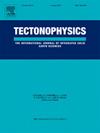Complex seismogenic fault system for the 2022 Ms6.0 Maerkang (China) earthquake sequence resolved with reliable seismic source parameters
IF 2.7
3区 地球科学
Q2 GEOCHEMISTRY & GEOPHYSICS
引用次数: 0
Abstract
The Bayan Har block in central Tibetan Plateau is characterized by low historical seismicity and has rarely experienced M6+ earthquakes. However, on June 10, 2022, at 01:28 AM (UTC + 8), an 6.0 earthquake struck Maerkang in Sichuan Province, China, within the Bayan Har block. Four foreshocks and eight aftershocks with magnitudes greater than 3 occurred during the week of the mainshock with the largest foreshock reaching 5.8. Previous studies have suggested two probable seismogenic faults. One proposes that the earthquake sequence occurred on the V-shaped Songgang secondary fault, while the other suggests an unmapped fault located east of the V-shaped fault is the causative fault. Additionally, there are inconsistencies in the focal depth and rupture direction in these studies. To better identify the seismogenic faults of the Maerkang earthquakes, we first estimated the focal mechanisms and centroid depths of all M2.9 events during one week of the mainshock occurence, using both regional and teleseismic waveform data. We then refined the mainshock epicenter by by incorporating 3D velocity models to account for their influence on the earthquake location. Other events were relocated relative to the mainshock using the surface wave differential times. Finally, we analyzed the rupture directivity of the mainshock and the 5.8 foreshock via the empirical Green's function (EGF) method. The results suggest that the mainshock likely ruptured along an unmapped fault to the east of the V-shaped Songgang secondary fault, while the 5.8 foreshock occurred on the Songgang fault itself, suggesting complex fault system for the earthquake sequence.
用可靠震源参数解析2022年中国马尔康Ms6.0地震序列的复杂发震断裂系统
青藏高原中部巴颜喀尔地块历史地震活动性低,很少发生M6+级地震。然而,在2022年6月10日凌晨1点28分(UTC + 8),一场6.0级地震袭击了中国四川省的马尔康,位于巴彦喀尔地块内。主震一周内发生了4次前震和8次3级以上余震,最大的前震达到5.8级。先前的研究提出了两个可能的发震断层。一种认为地震序列发生在v型松岗次级断层上,另一种认为位于v型断层以东的未测绘断层是诱发断层。此外,这些研究在震源深度和破裂方向上也存在不一致。为了更好地识别梅尔康地震的发震断层,我们首先利用区域和远震波形资料估算了主震发生一周内所有M≥2.9事件的震源机制和质心深度。然后,我们通过结合3D速度模型来考虑它们对地震位置的影响,从而改进了主震震中。利用面波差分时间相对于主震重新定位其他事件。最后,利用经验格林函数(EGF)方法对主震和5.8级前震的破裂指向性进行了分析。结果表明,主震可能沿v型松岗次级断层以东的未绘制断层破裂,而5.8级前震发生在松岗断层本身,表明地震序列的断层系统复杂。
本文章由计算机程序翻译,如有差异,请以英文原文为准。
求助全文
约1分钟内获得全文
求助全文
来源期刊

Tectonophysics
地学-地球化学与地球物理
CiteScore
4.90
自引率
6.90%
发文量
300
审稿时长
6 months
期刊介绍:
The prime focus of Tectonophysics will be high-impact original research and reviews in the fields of kinematics, structure, composition, and dynamics of the solid arth at all scales. Tectonophysics particularly encourages submission of papers based on the integration of a multitude of geophysical, geological, geochemical, geodynamic, and geotectonic methods
 求助内容:
求助内容: 应助结果提醒方式:
应助结果提醒方式:


